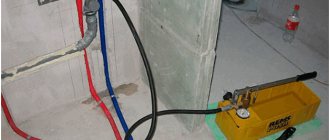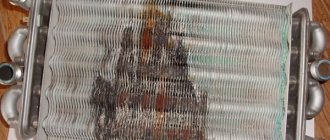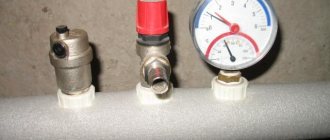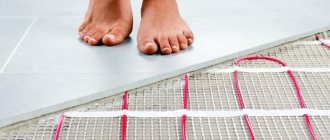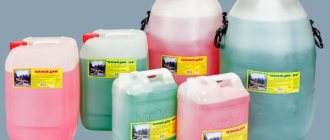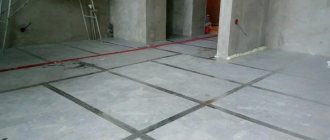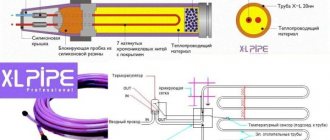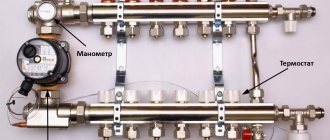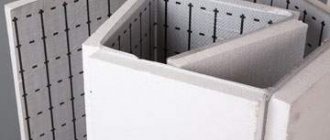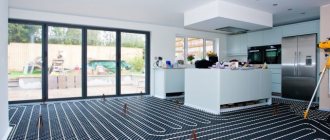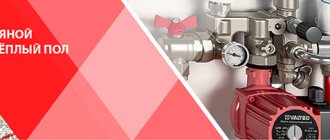A warm water floor is an excellent additional option for heating an apartment, and in a private house this system is often the main and only source of heating. The efficiency and duration of operation of the device depends not only on the correct installation, but also on how the heated floor was poured.
To fill the floor in a house, you need to divide its surface into rectangles. You need to start from the corner farthest from the entrance. Using guides, fill each area with a 10 cm layer and level it with a shovel. The entire surface is rolled with a needle roller to remove air bubbles and then leveled as a rule. After pouring is completed, the guides are removed and these places are filled with concrete.
The screed plays a large role in this design; it is responsible for protecting the circuit from mechanical damage, and for the correct distribution and exchange of heat. Therefore, when pouring a heated floor, you need to follow a number of rules, which we will discuss in detail in the article.
How to fill a heated floor
How to properly fill a water-heated floor - there are three methods that can be used. All of them are simple in technology, their process is similar, although each method has its own characteristics.
| Floor filling method | Description | pros | Minuses |
| Concrete | A common option is a cement-sand composition. To give greater strength to the floor structure, sand is replaced with filler. It prevents the base from crumbling when heated. In addition, when using filler, the thickness of the mortar layer decreases from 50 to 30 mm. | Strength, durability and uniform heating of the floor surface. | Significant floor weight and long curing period. |
| Semi-dry composition | The main difference is that it contains less water than in the first composition. Mandatory presence of polymer additives and fiber fibers. | Increased strength of the floor, dries much faster, has less shrinkage and the resulting surface from this composition is practically not subject to cracking. | Less plastic, this may cause voids. After drying, the resulting base should be protected from water. |
| Self-leveling mixtures | The composition resembles a cement-sand mixture. It can be used to make both a rough base for the floor and a finishing coating. But for screeding a warm water floor, only a coarse leveler is suitable. It comes with different bases: gypsum and cement. Both types can be used to fill heated floors. | It has the greatest plasticity, hardens quickly, and does not require careful leveling, as it spreads under its own weight. | High price. |
Preparation
To make the floors wear-resistant, it is best to use M400 or M500 cement when preparing the mortar. As for the added sand, it should have large grains, approximately 0.8 mm in diameter. This will protect the surface from the appearance of cracks and other defects. The fine fraction of sand used for bricklaying is not the best option. When installing a warm water floor, a thickness of at least 20 mm will be required, depending on the type of screed. Use the concrete volume calculator to determine the quantity.
There is one nuance that allows you to eliminate the liquid solution - adding water in portions. The important thing here is to eliminate the possibility of using too much water.
Dry cement mixtures M300 sand concrete are presented in finished form. Here you no longer need to think about proportions and getting a quality fill. Dry mixtures can only be diluted with the required amount of water, which is prescribed in the instructions from the manufacturer. Separately, it is very difficult to obtain all the required components of the semi-dry mixture for pouring a warm water floor. For this reason, it is better not to experiment, but to buy a ready-made version for installation.
Each type of mixture can be accompanied by plasticizers that can give the final solution more qualities and characteristics. In any case, even if they are included when purchasing, you should adhere to the mixing options indicated on the package. If it is difficult to decide which mixture to choose for underfloor heating screed, it is better to seek help from specialists or company representatives.
Temperature gaps
The main reason why cracks appear on a concrete screed is the incorrect location of expansion gaps.
According to the instructions, when installing a screed heated floor in rooms with a complex layout or having a large area, it is correct to divide the room into zones before pouring the concrete. The demarcation needs to be done with a damper tape, 5-10 cm thick, and the entire area along the walls is laid with it.
The damper tape helps protect the heating system from damage, because during the heating process the structural elements expand. If you do not install the damper tape, the concrete floor screed will quickly crack.
There are several points by observing which you can correctly arrange expansion joints:
- Each zone that is fenced with tape should be no more than 30 m2, and the sides should be no more than 8 meters long.
- If the room has a complex layout, it is divided into square or rectangular zones.
- In some conditions, it is possible to make divisions at 1/3 of the depth of the solution.
- After the floor screed has hardened, the seams are sealed.
Features of the solution
The use of a mixture for a heated floor when pouring a concrete screed is somewhat different from those rooms where there is no heating. The operating mode of such a floor becomes somewhat more complicated, and, consequently, the requirements for the solution increase. Inside the cement screed under the heated floor, a temperature of 50 degrees is maintained. It becomes slightly lower closer to the base - within 30-35 degrees. The following installation errors may appear if you do not follow the installation technology and prepare the solution for screeding the heated floor poorly:
- Minor microcracks will begin to appear on the base, which will only increase in size over time. This can subsequently lead to destruction or damage to the floor covering.
- Due to the appearance of a large number of cracks, the layer of cement in the screed will begin to warp. The heating elements will also be damaged and the entire system will lose full efficiency.
- Temperature conditions will decrease not only inside the entire structure, but also near the base of the floor in the room. The cracks that appear have excellent thermal conductivity, and heat will escape through them.
To prevent all this from happening during the operation of the water heated floor, the prepared screed for pouring onto the pipeline must have a certain set of technical characteristics:
- Low period for cement setting. The likelihood of residual stress will increase depending on how long it takes for the solution to dry completely. In addition, the setting process may vary: in one area there is still moisture, in another - everything is dry.
- Minor porosity. The efficiency of the water heated floor system will be higher if the density of the entire structure reaches its maximum. At the same time, the thermal conductivity of the structure increases.
- High strength. Cement-sand screed for heated floors must be able to withstand external loads and mechanical stress.
- Low probability of cracks appearing on the base. If this indicator can be achieved, then the pipeline itself will not be bent or damaged during operation.
Preparatory work
Before pouring the screed onto a warm water floor, some preparatory work is required:
- level and clean the base;
- install a heating system.
When installing a heated floor, you need to fill it after installing the entire “pie”; it is important to lay all its layers correctly.
The sequence of laying layers in the “pie” of a warm water floor is as follows:
- Rough screed - it is cleaned and leveled.
- Waterproofing - a polyethylene film with a thickness of 200 - 250 microns is placed.
- Thermal insulation - foamed polyethylene with foil coating is installed.
- Reinforcing mesh - it is necessary to give strength to the structure. In addition, pipes can be attached to it if the polystyrene foam base with bosses does not fit.
- Heating circuit (metal-plastic or polypropylene pipes with a cross-section of 20 mm) - it is fixed either to the mesh with special fasteners, or is laid on polystyrene plates between the bosses.
- Reinforcing mesh - it can be laid on top of the heating system, if desired, to give greater strength to the structure.
Before filling, it is necessary to connect the system to the collector, check it for leaks and how it heats . After which, a beacon is installed, which helps to obtain a level base from the concrete composition.
Installation nuances
When installing a screed for a warm water floor, you should remember that there are certain subtleties that must be known before starting work. The density of the solution used is very high, resulting in a reliable structure that can withstand external mechanical influences.
The solution can also be used to arrange beacons on the surface of the base in the form of cones. Beacons should be laid in a straight line and strictly following the building level. According to these beacons, guide profiles made of steel are laid. All this will allow you to fill the future screed smoothly and efficiently.
Concrete is poured along the exposed beacons, along the lower edge of the profiles, which are subsequently removed. All possible areas with superficial damage to the floor must be sealed with concrete mortar.
seam damper separator
We must not forget about the damper tape, which serves as a compensator for the thermal expansion of the completed screed. It is most often made from foamed polyethylene. All subsequent work should be carried out only after the solution has completely dried.
Installation of damper seams
Depending on the composition, the time frame for carrying out the work will vary. The mixture will harden much faster with less water.
There may be cases of obtaining a not entirely flat surface in order to lay floor coverings such as carpet or linoleum. In this case, resort to additional leveling using leveling compounds. The layer is insignificant and does not affect the difference in distance from the floor to the ceiling in the room. The maximum thickness of self-leveling fill reaches 5-7 mm. It is this indicator that elevation changes should not exceed.
When installing a screed for a heated floor, the proportions must be observed. This is what will allow you to get the desired result in the form of a durable and warm foundation.
Tools and materials we need to lay heated floors
Before installing and pouring a heated floor, you need to prepare tools and purchase building materials that will be needed for the work.
The main tools that will be required during the installation process:
- a level, preferably a laser one, to check the evenness of the poured floor;
- screwdriver - used for installing beacons;
- a hammer drill with a nozzle for mixing concrete or a construction mixer;
- capacity 100 liters - the solution will be mixed in it;
- slats and rule - for leveling;
- vacuum cleaner and broom - to clean the base.
We will also need to purchase the following building material:
- damper tape - for arranging thermal seams;
- insulation material - used for installing a heat-insulating layer;
- polyethylene film - for waterproofing;
- material for making the composition for pouring (sand, cement, plasticizers, fiber) or ready-made mixture;
- reinforcing mesh;
- beacons;
- fasteners - to secure the circuit to the reinforcement;
- pipes made of polyethylene or metal-plastic;
- polystyrene slabs with bosses - if pipes will be laid on them.
You also need to remember about personal safety. For this you will need: rubber boots, they will protect your feet from cement dust, and knee pads, which protect your knees from injury when pouring the floor.
Pouring in winter
The strength of poured concrete decreases noticeably even at a temperature of +5°C. To prevent the solution from cooling in winter, it is necessary to pour it into wooden formwork designed for this purpose and heat it, using, for example, infrared heat sources.
In order for the solution to harden in winter, a minimum temperature of +10°C must be maintained until the concrete reaches 70% of its strength.
Heat gun
For heating it is allowed to use:
- thermal curtains;
- electric heating cables;
- electric heat guns;
- heat generator (it will have to be covered with concrete).
The use of the listed devices must be done carefully, without over-drying or leaving individual areas cold. If the conditions are acceptable, the concrete will gain half its strength within 4 days.
A short-term freezing of the screed will not cause serious harm, but its top layer may crack and crumble. In order not to completely freeze and destroy the concrete, you need to cover it with thick plastic film. In this case, you can expect that with the onset of spring warming, the concrete will begin to harden.
Expert opinion
Sergey Permyakov
Heating systems engineer
An important condition for pouring heated floors in winter . In a private house, the thermal circuit must be closed before starting pouring work. Those. Windows and entrance doors have been installed. A good option is to cover the window openings with reinforced polyethylene film in two layers. In this case, you can count on maintaining a stable above-zero temperature using heat guns.
Recommended thickness of floor screed
The height of a correctly poured screed is the same size around the entire perimeter. The efficiency of the heating device and the uniform heating of the floor depend on it. We suggest finding out the optimal, minimum and maximum thickness of the screed for a water heated floor.
Therefore, it is correct to fill a warm water floor with concrete only on a flat rough base.
The height of the screed is determined by the specifics of the room, in apartments - from 5 to 8 cm, in industrial facilities - 10 cm. At the same time, the layer under the contour is at least 1 cm, and above the pipes 3 cm.
In addition, the following points influence the correct determination of thickness:
- when using a conventional cement-sand composition, the minimum thickness above the heating system is 5 cm;
- if the filling is made with plasticizers, its thickness above the heating element can be less than 5 cm, but not less than 3;
- when installing a structure using reinforcing mesh, a thickness of 2 - 2.5 cm is acceptable, without it - at least 3 cm.
For your information! One of the functions of the screed is heat accumulation. Therefore, if there is a thin layer, the floor will cool faster, and the coolant will be heated more often. In this regard, the optimal thickness is considered to be 7 - 8 cm.
On the ground
The filling technology will be the same regardless of the type of land and where exactly the groundwater is located. To work, you will need concrete grade M300 (or higher) and reinforcing mesh.
Before pouring the screed, the earthen flooring is leveled and compacted. Medium-fraction crushed stone or gravel can be used as the first layer of backfill. A second layer of sand is laid on top.
Each layer of bedding is compacted using a vibrating plate or manually.
Then the base for the rough screed is covered with waterproofing. These can be specialized materials or thick polyethylene film.
A subfloor 5-10 centimeters thick can be poured onto the finished base.
Concrete production
The main indicator of concrete is density, which directly depends on the brand. In rooms with low load, grade 150 is sufficient. If we are talking about living rooms and other rooms where people appear more often, there is heavy furniture, and so on, it is better to purchase cement grade 300–400.
In some cases, additives are used. It is important to remember that a properly prepared composition does not require additional components, but if the budget allows and there is a desire to play it safe, then you can purchase such materials. Plasticizers are also very often used; they make the solution more elastic, making it easier to work with and fill in uneven areas.
For domestic premises, concrete grade No. 150 is quite sufficient.
If a regular mortar is prepared, then 1 part cement and 3 parts sand are required. It is very important to pre-sieve the cement and sand so that there are no lumps in them. Water must be added until the mixture has the consistency of thick sour cream. If screenings are used instead of sand, the proportion will be 1:6. If crushed stone is added, the ratio is as follows: 1 part cement, 4 parts crushed stone and 3 parts sand.
Important! Filling the floor with a composition containing crushed stone requires further leveling work.
There are also ready-made mixtures on sale that were manufactured strictly according to technology in the factory. They are more expensive than individual components, but in this case there is practically no risk of incorrectly preparing the composition.
Specialized mixtures will cost one and a half times more than a homemade solution, but the quality of the screed increases significantly
"Semi-dry" method
There is much less water in the solution for the “semi-dry” method. If the mixture is made correctly, it will be moist but not runny.
They check it this way: squeeze a little semi-dry solution in your palm. It should form into a plastic lump without cracks. This is the consistency of a factory-made solution. It is more difficult to level, but then you can rub it to a shine, and ultimately get a surface that is dense and durable in structure.
If you order such a solution ready-made, you need to explain for what purposes it will be used. This concrete layer can withstand heavy loads. It is of higher quality than when laying concrete using the “wet” method.
You will have to rub it very carefully; this requires skill and patience. You will need a long grater or trowel. Semi-dry mixtures from screenings are practically not amenable to smooth grouting, so it is ground with sandy mortar.
Pipe layout options
There are three types of installation of pipes for underfloor heating: spiral, serpentine or looping, with a double spiral. When installing pipes in a spiral, heat is distributed evenly throughout them, since the pipeline is directed towards the center of the room. Therefore, heat from the source flows to the center, and from the center it is directed to the collector. Spiral laying does not have sharp bends, but there are also few straight sections. Although this installation often uses fasteners. When laying with a snake, heat will come in from one side and come out from the other. As it moves away, the water will cool, and this will cause the far part of the pipe to heat up more than the near one. Therefore, the total length of pipes used in such a system should not exceed 70 m.
Advantages and disadvantages
The following other points count in favor of underfloor heating:
- savings during operation up to 45%;
- the ability to avoid installing radiators, which allows for better use of room space;
- The finishing coating is suitable from any material;
- the air warms up more evenly, there are no drafts;
- The comfort of being in a space heated by thermal radiation is much higher than with radiator heating.
However, there are also disadvantages, which include a drop in pressure in the heating system due to the coolant diverted to heated floors, as well as the inability to quickly find and repair a leak in the event of an accident.
In any case, the main argument in favor of underfloor heating is the ability to increase living comfort while saving significant money.
Brands
When choosing a dry ready-mix, you should give preference only to high-quality products. There are well-known brands that have proven themselves on the positive side. These include the following companies.
Knauf
The UBO Knauf cement-based mixture using granulated polystyrene foam has good thermal insulation and soundproofing. It is used as a universal solution that does not require additional coatings.
Boden Knauf's gypsum-based mixture using polymers allows you to create very thin surfaces from 2-15 mm. Thanks to these mixtures, it is possible to level out unevenness reaching 35 mm in height (even 80 mm).
- For roughing, Boden 30 mixture is suitable.
- Boden 15 is used as a self-leveling product based on gypsum with the addition of plasticizers.
- For universal processing, use Boden 25 on a gypsum basis with the addition of mineral components.
Ceresit
The CN 80 mixture is used for rough processing. The universal building mixture marked CN 175, CN 76, CN 88, Tomsit DG does not require additional coatings and dries very quickly. CN 68, Thomsit D, Thomsit DD is used as self-leveling. Levels substrates up to 60 mm thick.
"Osnovit" "Staroline T-41", "Mixline T-44" are universal mixtures. Level surfaces up to 150 mm thick.
Grupa Altas
The mixture “Typhoon Master No. 44, No. 45” is suitable for initial surface treatment.
- The mixture “Typhoon Master No. 41, No. 48” is used as a self-leveling mixture.
- "Typhoon Master No. 40, No. 47" is used as a universal mixture.
"Sarmat"
Mixtures “Optimal”, “Sarmat NV-42”, “Sarmat NV-40” are suitable for primary treatment of bases with large uneven areas.
- The Sarmat NV-45 mixture can be used as a self-leveling mixture.
- "Sarmat NV-43" is used as a universal solution.
Unis
The “Horizon” mixture is suitable for the initial treatment of bases with large uneven surfaces, and “Horizon-2” is used as a self-leveling mixture. “Horizon Eco-Pol” is used for universal floor treatment.
Bergauf
Base and Easy Boden mixtures are suitable for the initial treatment of bases with large uneven surfaces. Boden Inter Gross is used for universal surface treatment.
Ilmax
The ilmax X-plan mixture is used as a self-leveling mixture, and Ilmax 6600, Ilmax 6650, Ilmax 6705 gypsplan, Ilmax 6715 rapidplan are used as universal floor coverings.
Compositions based on well-known brands have similar components, but differ only in the type of sand. Small grains contribute to the formation of a more liquid consistency. The type of initial surface determines the use of a particular brand.
Universal products are convenient because they do not require additional coatings. However, their use requires special qualifications and knowledge. It is better to purchase the mixture in large stores.
Please pay attention to the release date. The earlier it was released, the worse the quality

